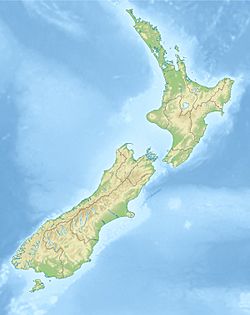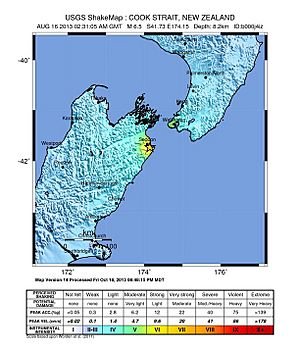2013 Lake Grassmere earthquake facts for kids
| UTC time | 2013-08-16 02:31:09 |
|---|---|
| ISC event | 604020963 |
| USGS-ANSS | ComCat |
| Local date | 16 August 2013 |
| Local time | 14:31:05 NZST |
| Magnitude | 6.6 Mww |
| Depth | 8 kilometres (5 mi) |
| Epicenter | 41°44′S 174°09′E / 41.73°S 174.15°E |
| Areas affected | New Zealand |
| Tsunami | None |
| Casualties | 4 people injured |
The 2013 Lake Grassmere earthquake was a strong earthquake that happened on Friday, August 16, 2013, at 2:31 PM. It had a magnitude of 6.6. The earthquake's starting point, called the epicenter, was about 10 kilometers (6 miles) southeast of Seddon. It was located under Lake Grassmere and was quite shallow, only 8 kilometers (5 miles) deep.
This earthquake caused a lot of damage to the land nearby. For example, landslides blocked roads, including the main highway between Blenheim and Christchurch. Buildings in Seddon were also damaged, and some were unsafe to live in. People felt the earthquake across both the North and South Islands of New Zealand.
Contents
What Caused the Lake Grassmere Earthquake?
Scientists believe this earthquake was connected to another big earthquake that happened earlier. On July 21, 2013, a magnitude 6.5 earthquake hit the Cook Strait. The Lake Grassmere earthquake is thought to be a "doublet" of that one. This means they are like a pair of earthquakes, happening on parts of the same fault system.
The Lake Grassmere earthquake also created its own series of smaller earthquakes. These are called aftershocks. Several of these aftershocks were quite strong, with some reaching magnitude 5 and one even reaching magnitude 6, all within a few hours of the main quake.
Aftershocks: Shakes That Follow
After the main earthquake, many smaller quakes, or aftershocks, continued to shake the area. The biggest aftershock had a magnitude of 6.0. These aftershocks can last for days or even weeks after a major earthquake.
Here are some of the larger aftershocks that happened after the main quake:
- August 16, 2013, 2:31 PM: The main earthquake, magnitude 6.6.
- August 16, 2013, 5:31 PM: A strong aftershock, magnitude 6.0.
- Many other aftershocks between magnitude 5.0 and 5.9 also occurred in the days following the main earthquake.
How Did the Earthquake Affect New Zealand?
The earthquake caused different levels of damage in various places.
Damage in Wellington
In Wellington, the capital city, buildings had minor damage. Some shop windows broke, and plaster cracked on walls. Many people working in city offices went home early. Train services were stopped so tracks could be checked for safety. This caused bus services to become very busy and traffic jams on major roads.
The city council also had to take down a 30-year-old lift shaft. It had been damaged in the earlier July earthquake, and its new safety restraints didn't work as planned. Buildings nearby had to be emptied to keep people safe.
Damage in Seddon
The town of Seddon was very close to the earthquake's epicenter. Many homes there were badly damaged. The local council had to evacuate eight houses, meaning people couldn't stay in them. Another 11 houses were only allowed limited access, meaning people could only go in for short times.
Other Areas Affected
People felt the earthquake across a very large area of New Zealand. It was felt as far north as Auckland and as far south as Dunedin. Damage was also reported in other areas like the Kapiti Coast, Hutt Valley, Blenheim, and Ward.



